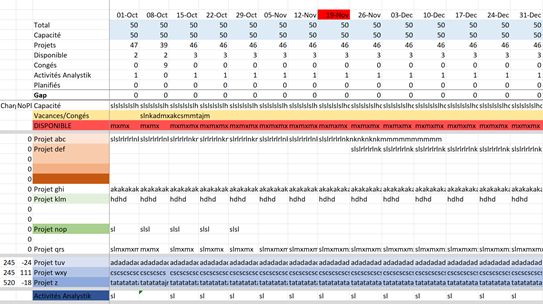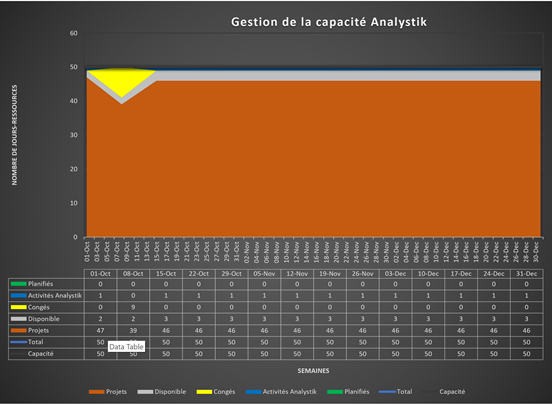The Services company faces more than one challenge in Software Development Project Management. Unlike a product company, a Service company must constantly match its sales to its ability to deliver. The goal is to serve customers well while avoiding “non-billable” time. Project / Production managers in a company generally face 3 main challenges:
- Capacity management
- Timeline
- Budget
Let’s analyze each of these challenges!
Software Development Project Management, an ongoing challenge on several levels
In addition to the difficulty of identifying its software development priorities, especially in times of pandemic, the Services company must constantly be on the lookout for any changes in the market in order to adapt to them and respond quickly.
In addition, it must implement rigorous project management processes so as not to let costs get out of hand, deadlines stretch and opportunities slip away due to a lack of capacity!
Capacity Management
Characterized by hiring management and bench management, capacity management is certainly one of the factors in a Services company that has the most impact on the “bottom line”. Indeed, paid employees who do not bill have a major impact on cash flow.
When the nature of the service offered is unique, capacity management is simplified because it becomes purely mathematical. The company has X resources available and the projects require Y resources. Capacity Management becomes much more difficult when different business lines come into play. In the information technology (IT) sector, for example, there will be analysts, programmers, architects, etc., who are all involved in the project. The company is often in a position where it lacks, for example, “architect” type resources and has too many “programmer” type resources.
Obviously, a large company will be at an advantage because it is able to “smooth” its resources.
It’s easy to understand that managing capacity in a multi-business and multi-project context is a great puzzle and that it is difficult to solve without tools. Of course, there is a whole range of tools, from Excel spreadsheets to Microsoft’s Project, a project management tool that is not intended for small businesses because it is too complex.
Each company must therefore find the right balance in the way it manages this capability. In some small businesses, there is still sometimes a “one man show” that can distribute resources, let’s hope it’s healthy. Otherwise, most small and medium-sized businesses need to equip themselves with management tools; Excel is certainly the one that will be found most often.
At Analystik, we still use a Gantt to plan and visualize at a high level the distribution of our resources.


In a company that has to manage hundreds of resources from different business lines and several projects at the same time, the tool may need to be more advanced and more complex.
Regardless of the tool used, a common problem found with these tools is that they are not interconnected, and the monitoring of ongoing projects requires constant readjustments and a lot of follow-up work. We will get back to that topic and with possible solutions in a future post.
Timeline / Schedule Management
The second challenge for Project/Production managers in Service companies is schedule management. The impact here is customer satisfaction and capacity management when the project “stretches”.
In the IT sector, the notion of “Agility” has been around for a long time. This methodology allows us to steer projects by the Added Value and not by the Plan. When this methodology is applied, costs and time are fixed.
To achieve this, the project (the deliverables) is broken down into tasks. Then, the deliverables are grouped into “Sprint”, which is actually a definition of the deliverables to be delivered at the end of a given period, usually three weeks.
Two major products allow us to apply this methodology: DevOps and Jira. It should be noted that these products track the “Remaining To Do” and not the time executed in a given project or task. They can therefore be used to calculate the deadline but not the actual cost of the project.
These products are really well used by the IT community. They allow to gather a group of individuals around the same objective, the deliverables of a Sprint.
Therefore, an IT project, managed in Agile mode, is the result of delivering a set of Sprints and the deliverables are “adjusted” to meet the delivery deadlines.
For traditional projects, especially when they are long projects, the risk of exceeding deadlines is more present. A good way to control time is to manage change requests. In fact, change requests are an integral part of projects and are often the main cause of cost and schedule overruns and resulting conflicts. If change requests are professionally managed, everyone involved knows the impact of a request in terms of delays, costs, extra work and even code rewriting. Therefore, there are no surprises when the project arrives at the end of the original schedule.
Budget Management
This is the third challenge for Project / Production Managers of Service companies. Fortunately, when the first two challenges are well met, this one is easier to control. Indeed, we have indicated above that there are two main methodology of Project Management, the first is driven by the plan and the second by the value. In a plan-driven project, costs are one of the two variable factors, so one must be vigilant. In Agile mode, costs and time are normally fixed, it will be the scope that will vary, therefore the deliverables. In normal times, it will be easier to track costs.
Most of the budget problems come from two main sources:
- Change requests
- Under-evaluation of tasks
Clients almost always end up making new requests… through the wrong channel, for example, directly to a developer or team leader. In addition, some teams often undervalue Tasks. What to do then?
To ask the question is to answer it; to follow up on change requests and to evaluate the tasks. And then again! To help you control the budget, you should have a very valuable piece of information: the “projection” of a project, which is the sum of the actual time executed plus the time left to do!
In a future post, we will tell you about a tool that calculates projections.
Conclusion
What else is there to say but that proper follow-up of your projects will allow you to proceed with fair invoicing, which will lead to healthy relationships with your customers… and probably more recurring sales!
Happy Project!




Leave a Reply